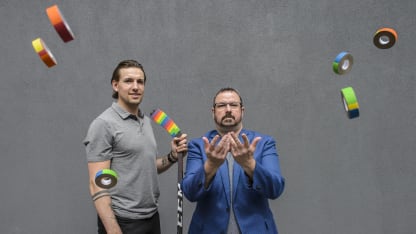"He said 'I think there's a guy who still has Pride tape on the end of his stick from warmup,'" McLean said. "I was freaking out. I was trying to get the right picture of it on my phone, trying to rewind and fast forward. Then Kurtis was in the penalty box and I'm, like, 'Oh I can see the stick while he's in the penalty box. They keyed in on him and there was the stick leaning against the glass with all the colors and it was, like' 'Wow, this is so surreal.' It still is.'"
McLean, Petruk and Kris Wells, who was then the faculty director of the University of Alberta's Sexual Minority Studies Services, helped create Pride tape in 2016 as a response to homophobic statements made in society, on social media and particularly in sports.
"We discovered that there were kids leaving sports at early ages, they were coming into their own sexuality, because they didn't feel safe in a locker room environment," McLean said.
RELATED: [NHL, NHLPA to celebrate Pride Month]
McLean, a hockey fan, said they decided to focus on hockey and decided that rainbow-colored tape would be the perfect product to convey a message "which speaks volumes without having (its users) say a word."
The questions were could they actually make a functional multi-colored tape that looked good on a stick and who would use it?
They raised more than $50,000 to manufacture the first 10,000 rolls of tape through a Kickstarter campaign that included contributions from Brian Burke, who was then the president of hockey operations for the Calgary Flames.
His son, Brendan Burke, was an openly gay hockey player who died in a car accident in February 2010 at the age of 21.
The Edmonton Oilers were the first professional team to embrace Pride Tape. Players had it on their sticks during an Oilers team skills competition in 2016.
A stick with Pride Tape from then-Oilers forward Beniot Pouliot is on display at the Hockey Hall of Fame in Toronto. Soon afterwards, pro leagues in Great Britain and Australia asked for the tape, McLean said.





















